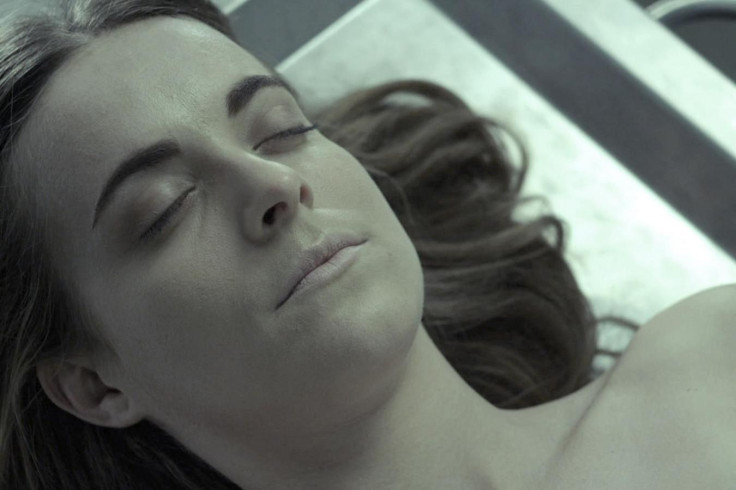'The Corpse Of Anna Fritz': Necrophilia Movie Pushes The Horror Boundaries At SXSW

A gurney on its way to the morgue comes into focus as several news sound bites introduce the character of Anna Fritz (Alba Ribas) to the SXSW audience for "The Corpse of Anna Fritz." Fritz was the most glamorous, the most giving celebrity to her fans, and now she is mysteriously dead, with her body kept at an undisclosed Spanish hospital. A young mortician named Pau (Albert Carbó) snaps a picture of the dead celeb and sends it to his friends. Ivan (Cristian Valencia) and Javi (Bernat Saumell) show up in quick succession to see her for themselves.
Maturity is in short supply among the three. Ivan suggests they take advantage of the corpse. When Pau is having his turn with Fritz’s body, she wakes up. Now two of the three guys have raped a celebrity, and it’s not long before their thoughts about what to do next turn to murder.
It’s a claustrophobic experience being in the morgue for so long with these characters, not unlike a Luis Buñuel conceit. At one point in the film, the characters cannot leave the morgue because they are locked inside. The audience is supposed to feel as trapped as Fritz does within her awakening body, unable to regain full mobility.
“The Corpse of Anna Fritz” bears some resemblance to the much more offensive “Deadgirl,” released in 2008. In that American film, two high school seniors come across an undead female body chained in an abandoned asylum and one of them comes up with a similarly chilling idea to take advantage of her. “Deadgirl” plays like a male fantasy, where the good protagonist is rewarded with an undead version of his lifelong crush.
What differentiates “Anna Fritz” from “Deadgirl” is that Fritz’s struggle to survive is just as much a part of the film as the guys’ bumbling attempt to save their reputations. She’s an actress and makes good use of trying to get herself out of the situation by turning them against each other. In a break for escape, Fritz does whatever possible to get to safety. She’s on her own to figure out the means of survival since none of the men can be trusted to save her.
The three young men in “The Corpse of Anna Fritz” boil down to three different responses to this sort of situation. Ivan takes full unapologetic advantage of an unresponsive body and makes crude remarks about silent women being “his type.” Pau takes advantage of the situation because he thinks he can get away with it. He reveals to his friends this isn’t the first corpse he has defiled, and assures them there’s little accountability. Javi is repulsed by the situation and tries to save Fritz. Ivan takes this as a breach of their friendship and retaliates out of fear the woman will press charges.
The urge in horror films to push the boundaries has existed since the genre’s beginnings, and as censorship laws have eased, those boundaries have shifted. Film festival are not as beholden to MPAA regulations as commercial distributors are, and therefore can exhibit unrated works. Theaters that might not otherwise be able to sustain a weeklong booking of a Spanish horror film about necrophilia can breathe easy knowing the film festival that rented their screens will do its best to fill the seats.
And horror itself has changed over the years. Silent classics like “The Cabinet of Dr. Caligari” or “Haxan” probably would frighten few viewers today. The iconic Universal monsters of the '30s might have scared audiences then, but wouldn’t keep us up at night now. As a kind of reaction to the violence of the '60s and the fall of the production code, horror in the '70s took a bloodier turn with rape and revenge plotlines (“The Last House on the Left”) and slasher features that targeted teens (“The Texas Chain Saw Massacre,” “Halloween”).
Horror always taps into primal fears, and in “The Corpse of Anna Fritz,” much of that fear is based in her inability to defend herself. She is both terrified and unable to get herself out of her situation, passively stuck on the gurney for much of the film. Rape, or the threat of rape, has a long history as a movie plotline (dating back at least as far as "The Birth of a Nation"), but because of changing modes of production and exhibition, audiences can now be made uncomfortable just by watching Fritz’s eyes water up when she wakes up in midassault.
Despite its short running time, “The Corpse of Anna Fritz” begins to lose its momentum halfway through. The boys' arguments start feeling thin and repetitive. Fritz’s thrilling dash for escape makes for a great sequence (with a nod to the Bride’s struggle to regain the use of her legs in "Kill Bill"), but beyond those glimmers of action, the film drags its feet to its inevitable conclusion.
This is director Hèctor Hernández Vicens’ first feature, but you can hardly tell from the movie itself. When the movie is good, it’s very good, with green-tinged morgue lighting playing from different perspectives. But better pacing is essential for movies to thrill midnight crowds. The dull déjà vu moments feel heavier to watch after a long day at South by Southwest. Ultimately, “The Corpse of Anna Fritz” would have been better as a short film.
SXSW runs March 13-21. Follow the rest of my coverage on Twitter at @mcastimovies.
© Copyright IBTimes 2024. All rights reserved.






















